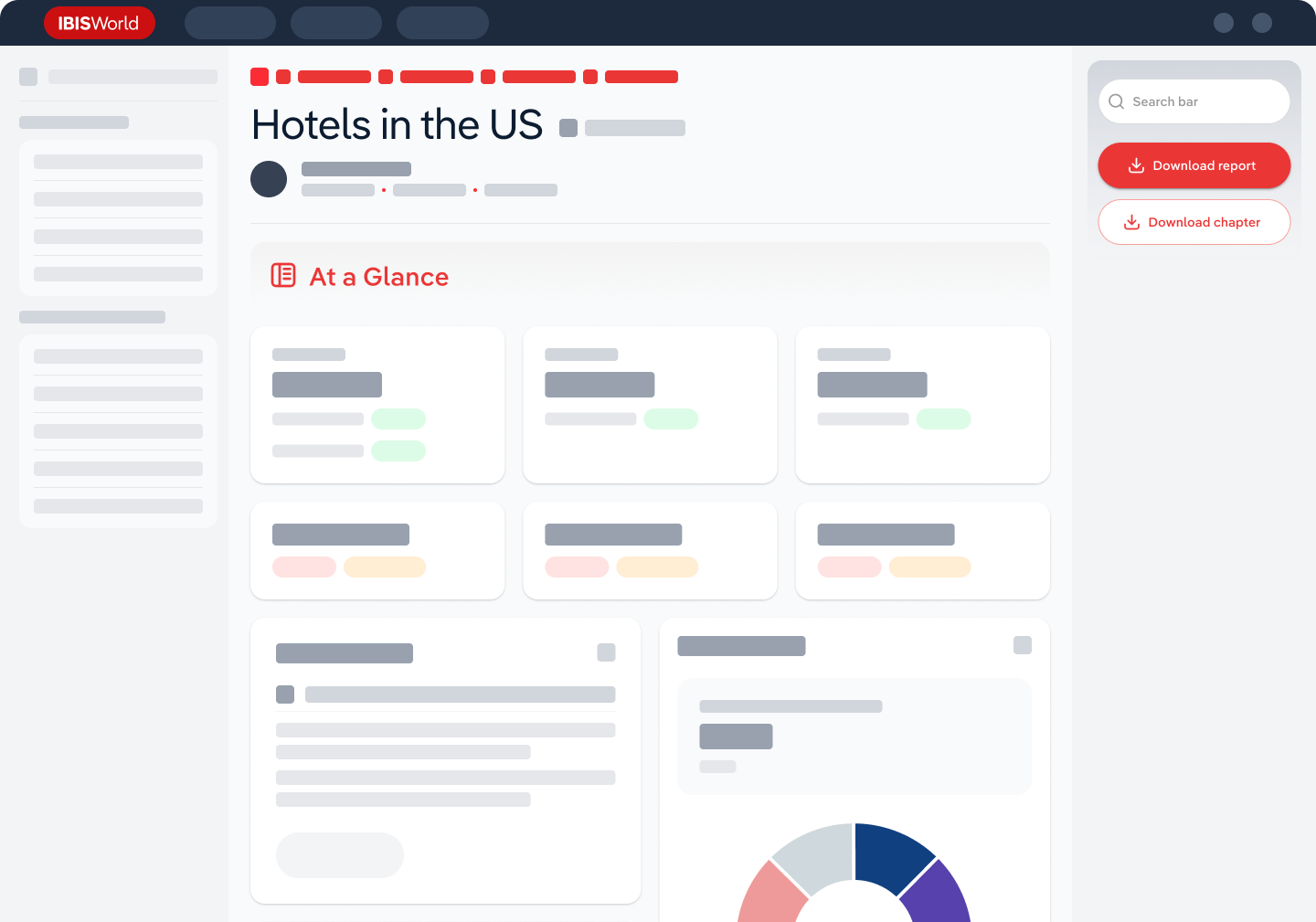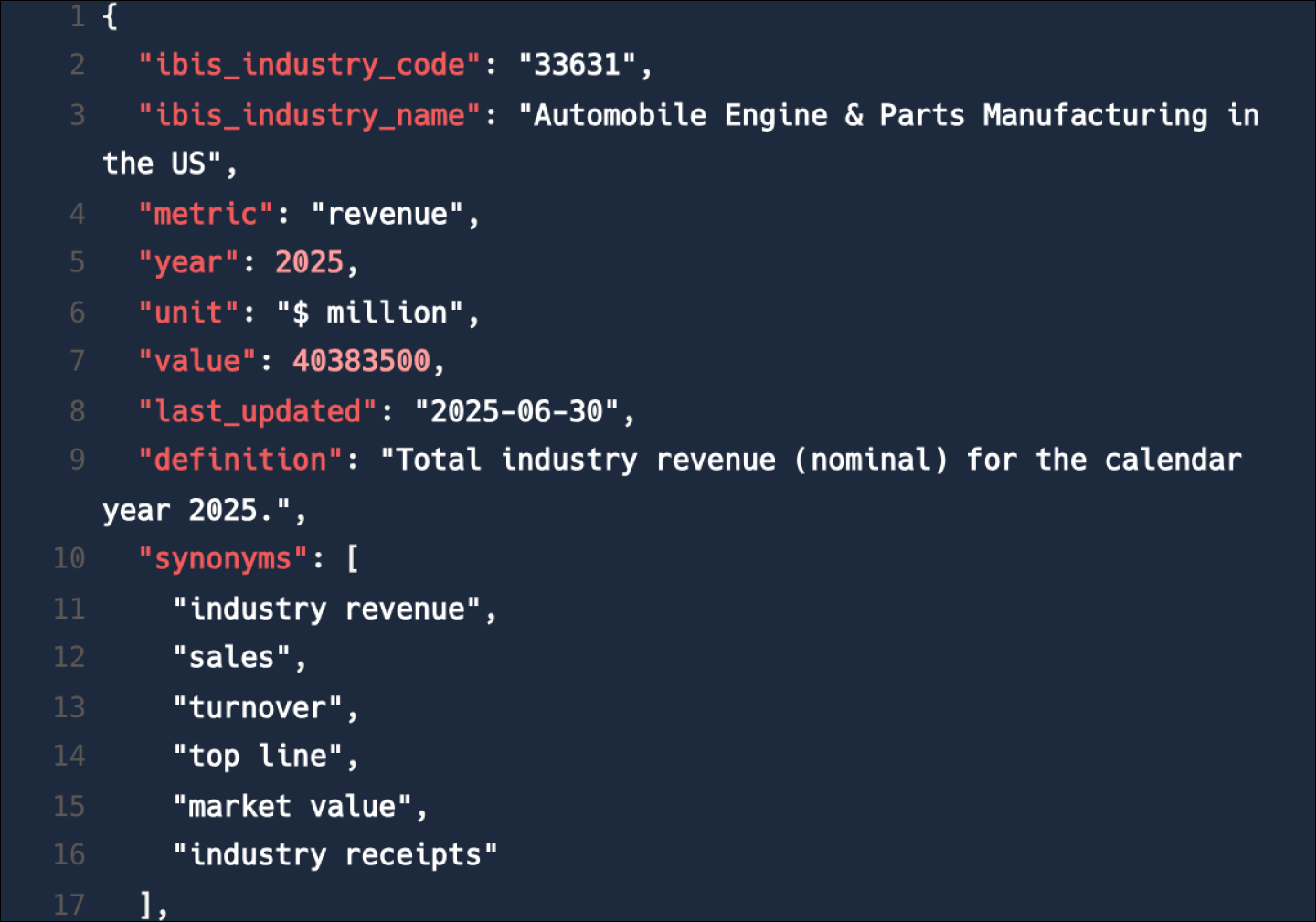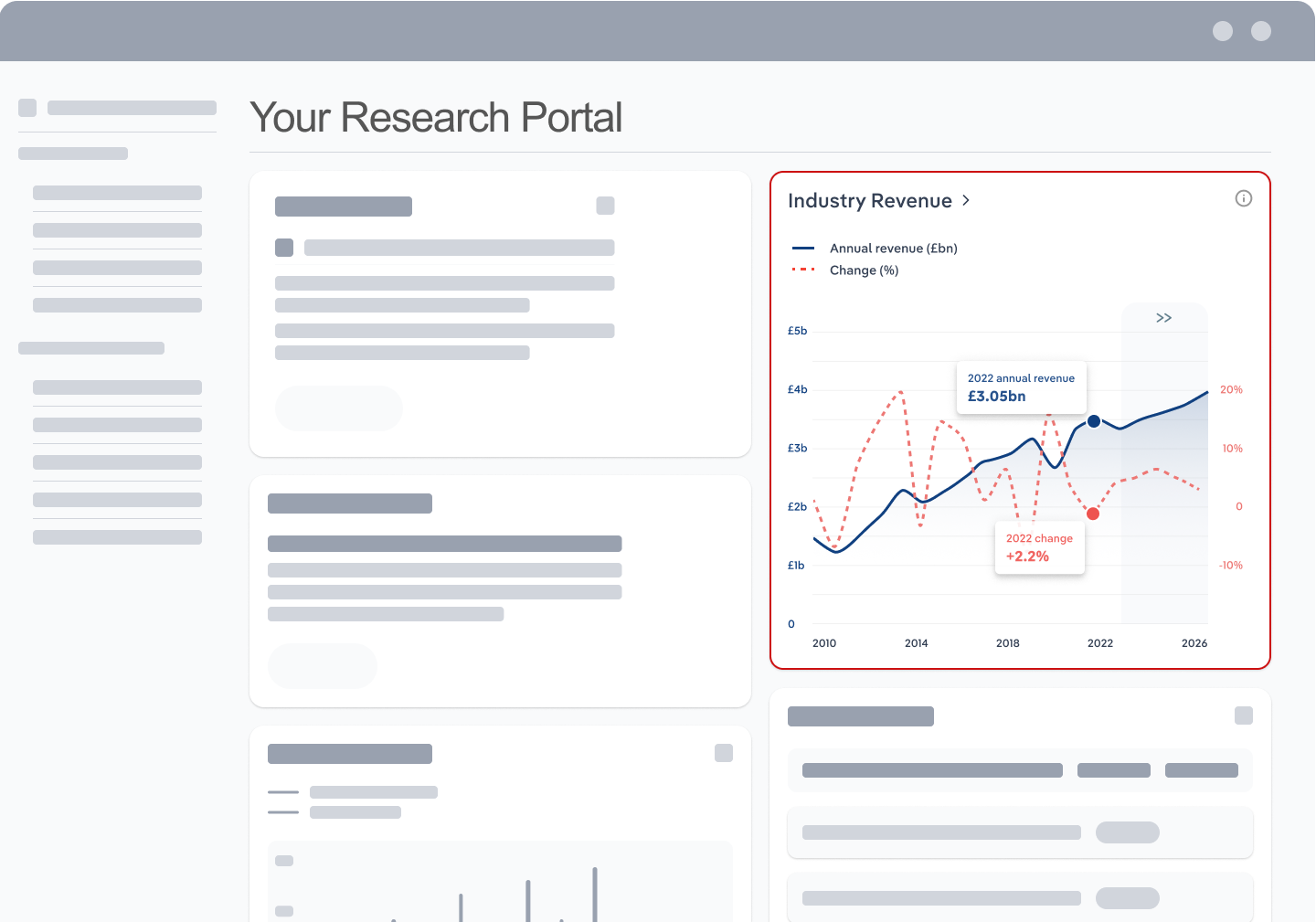Industry Statistics and Trends
Market size and recent performance (2015-2030)
Industry revenue has grown at a CAGR of 3.3 % over the past five years, to reach an estimated $21.4bn in 2025.
Trends and Insights
Population growth and increased vehicle ownership has boosted demand
- Demand for new motor vehicle parts sold by industry wholesalers has increased over the past five years, resulting in growth in revenue, employment, establishments and wages.
- Additional trends and insights available with purchase
Industry outlook (2025-2030)
Market size is projected to grow over the next five years.
Trends and Insights
The need for sophisticated new parts will elevate industry revenue
- Motor vehicle manufacturers increasingly use sophisticated parts and accessories, leveraging advanced technology to deliver new products to customers. This trend will continue to pressure motor vehicle new parts wholesalers to offer diverse products to satisfy various client needs. Those that can adapt to provide diverse product ranges will be better positioned to boost revenue as new sophisticated parts and accessories typically have higher prices than older parts.
Biggest companies in the Motor Vehicle New Parts Wholesaling in Australia
| Company | Market Share (%)
2026 | Revenue ($m)
2026 |
|---|---|---|
GPC Asia Pacific | 1,988.5 | |
Bapcor | 1,201.3 | |
Toyota Motor Corporation | 555.5 |
To view the market share and analysis for all 4 top companies in this industry, view purchase options.
Products & Services Segmentation
Industry revenue is measured across several distinct product and services lines, including Transmissions, other parts and accessories, Tyres and Engines. Transmissions, other parts and accessories is the largest segment of the Motor Vehicle New Parts Wholesaling in Australia.
Trends and Insights
Tyre usage has fluctuated, influencing tyre sales volumes
- This segment includes different types of tyres for passenger vehicles, light commercial vehicles, trucks, buses and motorcycles.
- More insights available in the full report
Table of Contents
About this industry
Industry definition
The industry includes businesses that wholesale new motor vehicle and motorcycle parts and accessories like batteries, car audio systems, electronic components, motor vehicle and motorcycle tyres and other parts and accessories. Motor vehicle new parts wholesalers act as intermediaries between upstream manufacturers and downstream markets, including automotive parts and accessories retailers, car dealerships and mechanics.
What's included in this industry?
Products and services covered in the Motor Vehicle New Parts Wholesaling industry in Australia include Tyres, Engines, Electrical components, Batteries, Transmission components, Brakes and shock absorbers and Gaskets, springs, wiper blades and exhaust systems.Companies
Companies covered in the Motor Vehicle New Parts Wholesaling industry in Australia include GPC Asia Pacific, Bapcor and Toyota Motor Corporation.Purchase this report to view all 4 major companies in this industry.
Related Terms
Related terms covered in the Motor Vehicle New Parts Wholesaling industry in Australia include aftermarket, hybrid vehicles and original equipment.Industry Code
ANZSIC 3504 - Motor Vehicle New Parts Wholesaling in Australia
Performance
Get an indication of the industry's health through historical, current and forward-looking trends in the performance indicators that make or break businesses.
Analyst insights
An ageing vehicle fleet has extended ownership cycles and sustained parts demand despite economic headwinds. The average age of commercial vehicles has increased, as cost-of-...
In this chapter (4)
- Current Performance
- Outlook
- Volatility
- Life Cycle
Key metrics
- Annual Revenue, Recent Growth, Forecast, Revenue Volatility
- Number of Employees, Recent Growth, Forecast, Employees per Business, Revenue per Employee
- Number of Businesses, Recent Growth, Forecast, Employees per Business, Revenue per Business
- Total Profit, Profit Margin, Profit per Business
Charts
- Revenue, including historical (2015-2024) and forecast (2025-2030)
- Employees, including historical (2015-2024) and forecast (2025-2030)
- Businesses, including historical (2015-2024) and forecast (2025-2030)
- Profit, including historical (2015-2025)
- Industry Volatility vs. Revenue Growth
- Industry Life Cycle
Detailed analysis
- Trends in supply, demand and current events that are driving current industry performance
- Expected trends, economic factors and ongoing events that drive the industry's outlook
- Key success factors for businesses to overcome volatility
- How contribution to GDP, industry saturation, innovation, consolidation, and technology and systems influence the industry's life cycle phase.
Products and Markets
Learn about an industry's products and services, markets and trends in international trade.
Analyst insight
Motor vehicle parts and accessories retailers are the industry’s most prominent market. The end of passenger vehicle manufacturing in 2017-18 significantly shifted the balanc...
In this chapter
- Products & Services
- Major Markets
Key metrics
- Largest market segment and value in 2025
- Product innovation level
Charts
- Products & services segmentation in 2025
- Major market segmentation in 2025
Detailed analysis
- Trends impacting the recent performance of the industry's various segments
- Innovations in the industry's product or service offering, specialization or delivery method
- Key factors that successful businesses consider in their offerings
- Buying segments and key trends influencing demand for industry products and services
Geographic Breakdown
Discover where business activity is most concentrated in an industry and the factors driving these trends to find opportunities and conduct regional benchmarking.
Analyst insights
New South Wales holds the most wholesalers. Wholesalers situate themselves in proximity to major markets and heavily populated areas for ready access to sales.
In this chapter (1)
- Business Locations
Charts
- Share of revenue, establishment, wages and employment in each region
- Share of population compared to establishments in each region in 2025
Tables
- Number and share of establishments in each region in 2025
- Number and share of revenue each region accounts for in 2025
- Number and share of wages each region accounts for in 2025
- Number and share of employees in each region in 2025
Detailed analysis
- Geographic spread of the industry across Asia Pacific, and trends associated with changes in the business landscape
- Key success factors for businesses to use location to their advantage
Competitive Forces
Get data and insights on what's driving competition in an industry and the challenges industry operators and new entrants may face, with analysis built around Porter's Five Forces framework.
Analyst insights
Start-up costs are a small barrier for new entrants. Compared to the Motor Vehicle Manufacturing industry, wholesalers don’t need expensive plants or equipment.
In this chapter (4)
- Concentration
- Barriers to Entry
- Substitutes
- Buyer & Supplier Analysis
Key metrics
- Industry concentration level
- Industry competition level and trend
- Barriers to entry level and trend
- Substitutes level and trend
- Buyer power level and trend
- Supplier power level and trend
Charts
- Market share concentration among the top 4 suppliers from 2020-2025
- Supply chain including upstream supplying industries and downstream buying industries, flow chart
Detailed analysis
- Factors impacting the industry’s level of concentration, such as business distribution, new entrants, or merger and acquisition activity.
- Key success factors for businesses to manage the competitive environment of the industry.
- Challenges that potential industry entrants face such as legal, start-up costs, differentiation, labor/capital intensity and capital expenses.
- Key success factors for potential entrants to overcome barriers to entry.
- Competitive threats from potential substitutes for the industry’s own products and services.
- Key success factors for how successful businesses can compete with substitutes.
- Advantages that buyers have to keep favorable purchasing conditions.
- Advantages that suppliers have to maintain favorable selling conditions.
- Key success factors for how businesses can navigate buyer and supplier power.
Companies
Learn about the performance of the top companies in the industry.
Analyst insights
GPC’s growth strategy is focused on acquisitions. The company has been building the market for its wholesale operations by acquiring more and more automotive retailers.
In this chapter
- Market Share Concentration
- Companies
- Company Spotlights
Charts
- Industry market share by company in 2021 through 2025
- Major companies in the industry, including market share, revenue, profit and profit margin in 2025
- Overview of GPC Asia Pacific's performance by revenue, market share and profit margin from 2019 through 2025
- Overview of Bapcor's performance by revenue, market share and profit margin from 2019 through 2025
- Overview of Toyota Motor Corporation's performance by revenue, market share and profit margin from 2019 through 2025
- Overview of revenue, market share and profit margin trend for one additional company
Detailed analysis
- Description and key data for GPC Asia Pacific, and factors influencing its performance in the industry
- Description and key data for Bapcor, and factors influencing its performance in the industry
- Description and key data for Toyota Motor Corporation, and factors influencing its performance in the industry
- Description, key data and performance trends for one additional company
External Environment
Understand the demographic, economic and regulatory factors that shape how businesses in an industry perform.
Analyst insights
Population growth translates into vehicle fleet expansion and sustained demand for parts. Australia's expanding population drives increased vehicle ownership and usage, estab...
In this chapter
- External Drivers
- Regulation & Policy
- Assistance
Key metrics
- Regulation & policy level and trend
- Assistance level and trend
Charts
- Regulation & Policy historical data and forecast (2015-2030)
- Assistance historical data and forecast (2015-2030)
Detailed analysis
- Demographic and macroeconomic factors influencing the industry, including Regulation & Policy and Assistance
- Major types of regulations, regulatory bodies, industry standards or specific regulations impacting requirements for industry operators
- Key governmental and non-governmental groups or policies that may provide some relief for industry operators.
Financial Benchmarks
View average costs for industry operators and compare financial data against an industry's financial benchmarks over time.
Analyst insights
Motor vehicle new parts wholesalers have increasingly leveraged technology to enhance efficiency. This effort has helped wholesalers reduce their reliance on labour, which ha...
In this chapter
- Cost Structure
- Financial Ratios
- Key Ratios
Key metrics
- Profit margin, and how it compares to the sector-wide margin
- Average wages, and how it compares to the sector-wide average wage
- Largest cost component as a percentage of revenue
- Industry average ratios for days' receivables, industry coverage and debt-to-net-worth ratio
Charts
- Average industry operating costs as a share of revenue, including purchases, wages, depreciation, utilities, rent, other costs and profit in 2025
- Average sector operating costs as a share of revenue, including purchases, wages, depreciation, utilities, rent, other costs and profit in 2025
- Investment vs. share of economy
Data tables
- Cash Flow & Debt Service Ratios (2015-2030)
- Revenue per Employee (2015-2030)
- Revenue per Enterprise (2015-2030)
- Employees per Establishment (2015-2030)
- Employees per Enterprise (2015-2030)
- Average Wage (2015-2030)
- Wages/Revenue (2015-2030)
- Establishments per Enterprise (2015-2030)
- IVA/Revenue (2015-2030)
- Imports/Demand (2015-2030)
- Exports/Revenue (2015-2030)
Detailed analysis
- Trends in the cost component for industry operators and their impact on industry costs and profitability
Key Statistics
Industry Data
Data Tables
Including values and annual change:
- Revenue (2015-2030)
- IVA (2015-2030)
- Establishments (2015-2030)
- Enterprises (2015-2030)
- Employment (2015-2030)
- Exports (2015-2030)
- Imports (2015-2030)
- Wages (2015-2030)
Top Questions Answered
Unlock comprehensive answers and precise data upon purchase. View purchase options.
What is the market size of the Motor Vehicle New Parts Wholesaling industry in Australia in 2025?
The market size of the Motor Vehicle New Parts Wholesaling industry in Australia is $21.4bn in 2025.
How many businesses are there in the Motor Vehicle New Parts Wholesaling industry in Australia in 2025?
There are 2,436 businesses in the Motor Vehicle New Parts Wholesaling industry in Australia, which has grown at a CAGR of 0.2 % between 2020 and 2025.
How may import tariffs affect the Motor Vehicle New Parts Wholesaling industry in Australia?
The Motor Vehicle New Parts Wholesaling industry in Australia is unlikely to be materially impacted by import tariffs with imports accounting for a low share of industry revenue.
How may export tariffs affect the Motor Vehicle New Parts Wholesaling industry in Australia?
The Motor Vehicle New Parts Wholesaling industry in Australia is unlikely to be materially impacted by export tariffs with exports accounting for a low share of industry revenue.
Has the Motor Vehicle New Parts Wholesaling industry in Australia grown or declined over the past 5 years?
The market size of the Motor Vehicle New Parts Wholesaling industry in Australia has been growing at a CAGR of 3.3 % between 2020 and 2025.
What is the forecast growth of the Motor Vehicle New Parts Wholesaling industry in Australia over the next 5 years?
Over the next five years, the Motor Vehicle New Parts Wholesaling industry in Australia is expected to grow.
What are the biggest companies in the Motor Vehicle New Parts Wholesaling industry in Australia?
The biggest companies operating in the Motor Vehicle New Parts Wholesaling industry in Australia are GPC Asia Pacific, Bapcor and Toyota Motor Corporation
What does the Motor Vehicle New Parts Wholesaling industry in Australia include?
Tyres and Engines are part of the Motor Vehicle New Parts Wholesaling industry in Australia.
Which companies have the highest market share in the Motor Vehicle New Parts Wholesaling industry in Australia?
The company holding the most market share in the Motor Vehicle New Parts Wholesaling industry in Australia is GPC Asia Pacific.
How competitive is the Motor Vehicle New Parts Wholesaling industry in Australia?
The level of competition is high and increasing in the Motor Vehicle New Parts Wholesaling industry in Australia.
Methodology
How are IBISWorld reports created?
IBISWorld has been a leading provider of trusted industry research for over 50 years to the most successful companies worldwide. With offices in Australia, the United States, the United Kingdom, Germany and China, we are proud to have local teams of analysts that conduct research, data analysis and forecasting to produce data-driven industry reports.
Our analysts start with official, verified and publicly available sources of data to build the most accurate picture of each industry. Analysts then leverage their expertise and knowledge of the local markets to synthesize trends into digestible content for IBISWorld readers. Finally, each report is reviewed by one of IBISWorld’s editors, who provide quality assurance to ensure accuracy and readability.
IBISWorld relies on human-verified data and human-written analysis to compile each standard industry report. We do not use generative AI tools to write insights, although members can choose to leverage AI-based tools within the platform to generate additional analysis formats.
What data sources do IBISWorld analysts use?
Each industry report incorporates data and research from government databases, industry-specific sources, industry contacts, and our own proprietary database of statistics and analysis to provide balanced, independent and accurate insights.
Key data sources in Australia include:
- Australian Bureau of Statistics
- Australian Taxation Office
- Australian Securities & Investments Commission
Analysts also use industry specific sources to complement catch-all sources, although their perspective may focus on a particular organization or representative body, rather than a clear overview of all industry operations. However, when balanced against other perspectives, industry-specific sources provide insights into industry trends.
These sources include:
- Industry and trade associations
- Industry federations or regulators
- Major industry players annual or quarterly filings
Finally, IBISWorld’s global data scientists maintain a proprietary database of macroeconomic and demand drivers, which our analysts use to help inform industry data and trends. They also maintain a database of statistics and analysis on thousands of industries, which has been built over our more than 50-year history and offers comprehensive insights into long-term trends.
How does IBISWorld forecast its data?
IBISWorld’s analysts and data scientists use the sources above to create forecasts for our proprietary datasets and industry statistics. Depending on the dataset, they may use regression analysis, multivariate analysis, time-series analysis or exponential smoothing techniques to project future data for the industry or driver. Additionally, analysts will leverage their local knowledge of industry operating and regulatory conditions to impart their best judgment on the forecast model.
IBISWorld prides itself on being a trusted, independent source of data, with over 50 years of experience building and maintaining rich datasets and forecasting tools. We are proud to be the keystone source of industry information for thousands of companies across the world.
Learn more about our methodology and data sourcing on the Help Center.










